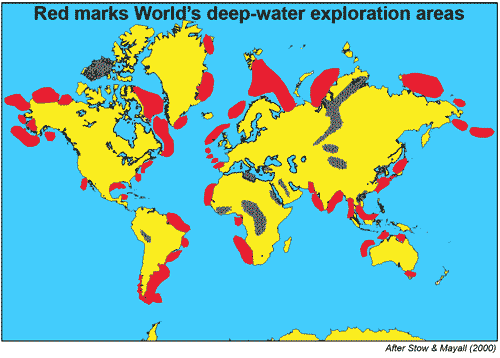Introduction to of Deepwater Clastic Systems
Preamble
The long history of interest in gravity-driven deep-water sedimentation is founded on the early works of Kuenen, Shepard, Bouma and others (link to Historical Review). Research in this field of sedimentary geology has recently accelerated. This is largely driven by the interest of the oil industry as their exploration on continental margins around the world has extended into increasingly deep water. Also parallel developments in seismic and seafloor imaging have provided fundamental new insights into the character and three-dimensional structure of deepwater deposits. Increasingly sophisticated laboratory and numerical simulations can now be used to replicate natural processes.

Deep-water systems are no longer viewed in isolation, but as an integral part of the margin response to up-dip accommodation and supply variations. These externally-forced changes provide a high-level framework in which to assess the behavior of successive gravity currents and the depositional architecture they build.
The new understanding of the processes and stratigraphy of deepwater systems is important to both the better prediction of sand occurrence during hydrocarbon exploration, and the assessment of the three-dimensional geometry and reservoir properties of the sandstones and interbedded non-reservoir facies during field appraisal and production.
Deepwater Clastic Systems Section Organization
This set of pages has ten sub-pages which will help the reader navigate through different subtopics related to deep-water systems. "Deep-water Processes and Sediment" provides an introductory summary to the classification and end members of deepwater deposits.The "Deepwater Sediment Structures" sub-page is the gateway to four sedimentary structures galleries including 1) deepwater fans and channels; 2) fining upward cycles; 3) flute casts and other similar structures and 4) mud volcanoes and similar structures. "Deepwater Elements and Architecture" provides an overview and figures of major morphological features produced by deepwater processes. The "Deepwater Source and Settings" sub-page walks the reader through where deepwater processes occur and which type of terrain deposits are tied to. The sub-page titled "Deepwater Sequence Stratigraphy" focuses on identifying markers and detecting evidence of sea level change through lithologic indicators. The remaining sub-pages provides images and locations of prominent deepwater sequences studied in outcrop, classroom exercises and references and finally a treatise on early works and researchers in the field of deepwater sedimentation.
Sunday, November 17, 2013